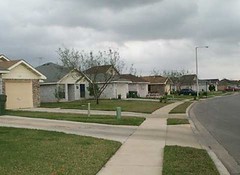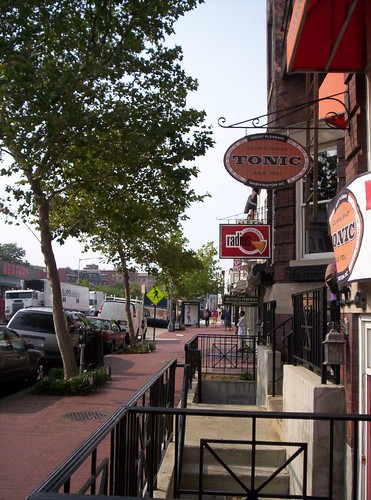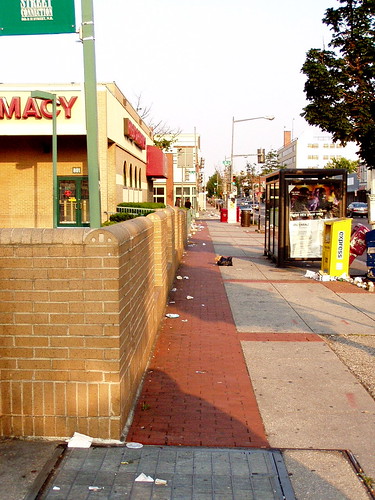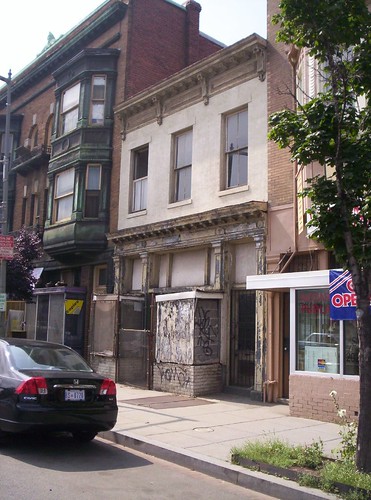Speaking of City Revitalization...assets, assets, assets
On the pro-urb list there has been a little kvetching over the Economist Intelligence Unit's ranking of city livability, which ranked cities like Pittsburgh and Cleveland highly.
From the press release: The Economist Intelligence Unit's LIVEABILITY RANKING, part of the Worldwide Cost of Living Survey, assesses living conditions in 127cities around the world by looking at nearly 40 individual indicators grouped into five categories: stability; healthcare; culture and environment; education; and infrastructure. The survey gives a rating of 0%-100% and judges a city with a lower score to be the more attractive destination. A rating of 20% is where real problems are seen to begin - anything over 50% places severe restrictions on lifestyle.
NORTH AMERICA. With low crime, little threat from instability or terrorism and a highly developed infrastructure, Canada has the most liveable destinations in the world. With a rating of just 1% (as a result of a small threat from petty crime) Vancouver is the highest ranked city of all 127 surveyed. A further two Canadian cities (Montreal and Toronto) feature in the top five with ratings of just 3%. All 4 cities surveyed score well in all respects.
Although higher crime rates and a greater threat of terror puts US cities below those of Canada, US cities are still among the world's most liveable. Cleveland and Pittsburgh are the joint best scoring cities in the United States (7%), in joint 26th place in the global ranking. A lack of availability of recreational activities and certain infrastructural shortfalls put Lexington as the least liveable US city surveyed, in 56th place-although its rating of 13% is still low.
Here's what I wrote--
You more than anybody ought to know about the various market "imperfections" that abet suburban lifestyle choices, plus the fact that city schools likely suck, and municipal institutions are probably somewhat schlerotic. I happen to like Cleveland a lot, and if I lived in that region, you'd find me eager to live in the Warehouse District, Tremont, or in the West Side Market area.
 I love Cleveland's West Side Market (photos from West Side Market, via www.pps.org)
I love Cleveland's West Side Market (photos from West Side Market, via www.pps.org) and so do other people!
and so do other people!But the city's businesses and population are still hollowing out, and will continue to do so.
Certainly, Pittsburgh is in bankruptcy, and Allegheny County has what 200+ municipalities? But it has many great neighborhoods, historic building stock, some incredibly innovative community organizations (Community Design Center of Pittsburgh, Pittsburgh History and Landmarks Foundation, Community Technical Assistance Center) and some great neighborhood-business revitalization organizations united by what I call a weak real estate market's "desperate willingness to experiment" and innovate, which doesn't usually typify strong real estate markets like DC (but includes NYC, but that's because overwhelming density attracts and incubates innovation through sheer numbers).
Even Washington DC has big problems in terms of lousy schools, inadequate retail, and difficulties in achieving quality municipal services (see this blog entry about how the recent death of a child could likely have been avoided had the DC Energy Office implemented workflow software procedures to address utility shutoffs due to inability to pay)--which is why I argue that the city's annual budget surpluses are somewhat of a chimera.
cf. The Future Once Happened Here for a discussion of city management and philosophy issues. In short, we have a ways to go.
The broader conditions of metropolitan regions impact the center cities greatly. As you know, I am one of the only staunch and voluble advocates for center cities on this list. There's a reason my .sig says "give me urban growth boundaries, or give me sprawl." As long as the city can't compete equally with the suburbs, and with an infrastructure and service base that is out of kilter with revenues, center cities are screwed in terms of being competitive.
But that doesn't mean that these particular center cities don't have many many neighborhoods that are eminently livable. It's not much different from Ann Arbor. I'd love to live there, but unless you have a decent job already, are a professor or a medical professional, it's a tough place to find a good job... but it sure is livable. Cleveland and Pittsburgh have similar employment issues...and a whole lot more problems compared to Ann Arbor, but many neighborhoods just as, if not more, livable than Ann Arbor.
And this is new--
Similarly, the Wall Street Journal ran a long article on Wednesday about "Eminent Domain: Is it only hope for Inner Cities?" (this article is not available online).
I think not.
First, most people make the mistake of comparing strong market cities to weak market cities. What you can do in DC is a lot different from what you can do in Newark. But the kinds of programs and projects you develop have to take this into consideration and too often they do not.
The impact of big projects (see the discussion in Cities Back from the Edge, which is one of the best books out there on urban revitalization) is about 1.5 blocks according Don Rypkema, a respected real estate and historic preservation consultant.
I am not saying that weak market cities should dial down their expectations, or even stop pursuing big projects, but as long as they have no tools to recenter development upon the city (which is what urban growth boundaries do, otherwise development continues to leak out into the farthest reaches of a region--only high gas prices might stop the recent trends of exurbanism), they have few options. And big projects aren't usually the panacea that they are made out to be...
To me the most sustainable and successful option is to focus on the extant assets and do everything possible to harvest the potential benefits. Usually, the most prominent assets are historic buildings, and walkable livable neighborhoods based on urban design principles that have been developed over the thousands of years that civilization practiced townbuilding. Unfortunately these lessons were cast aside in favor of the car. (See this blog entry "Updating my list of the "building blocks" of successful urban revitalization" for more discussion and a couple citations about this.)
Which neighborhood would you rather live in?
 The Windwood Subdivision, in Brownsville, Texas, (Photo www.cdcb.org)
The Windwood Subdivision, in Brownsville, Texas, (Photo www.cdcb.org) or this walkable urban neighborhood? (Photo www.beyonddc.com)
or this walkable urban neighborhood? (Photo www.beyonddc.com)Not everyone in a metropolitan area wants to live in the center city. But Center Cities can stabilize and improve their neighborhoods and increase population and businesses vis-a-vis their suburban competition. Don't focus on "the whole city", focus on your best assets and work from there.
One of the best assets where (not in a strong market) the center cities have a competitive advantage is in terms of "a large stock of old buildings". Not only do these buildings tend to be a lot more attractice and beautiful, they tend to be rentable much more cheaply in comparison to newer suburban construction. You don't have to attract everybody, just more people than you're getting now.
Which place would you rather shop?
 Historic building storefronts in Mt. Pleasant, Washington DC.
Historic building storefronts in Mt. Pleasant, Washington DC. Suburban strip style shopping in the center city. Photo by Elise Bernard.
Suburban strip style shopping in the center city. Photo by Elise Bernard. Of course, if you neglect your assets, you don't get much out of them either.
Of course, if you neglect your assets, you don't get much out of them either.Big projects are not the only hope for center cities, and cities do need to continue to grow and change to meet new realities, and big projects are part of this process. And I will say that Eminent Domain is a tool that cities need to be able to use to push foward. But it is a tool that needs to be used with great care, and with a great deal of transparency. Too often it is seen, justifiably, as a tool to make already rich people richer, and so people paint it with the same "noxious use" brush that I call "blaming the building" in another context.
In a Boston Globe op-ed on eminent domain ("Make eminent domain fair for all) , the authors make some good points about how such takings should be evaluated. I think the suggestions they offer provide a good framework for considering various public-private undertakings:
From the article:
State court judges have emphasized in the past that, to comply with the Massachusetts Constitution's own requirement that eminent domain be for a public use, the government must demonstrate that eminent domain will really benefit the public. New legislation could respond to that by:
-- Requiring, as Justice Anthony M. Kennedy suggested in his Kelo concurrence, that any exercise of eminent domain for economic development have a primarily public purpose rather than a merely incidental one.
-- Requiring the government to demonstrate the public benefit through a full-scale financial analysis that could be challenged in court.
-- Requiring that eminent domain not be used for a solely fiscal purpose and that it instead must be part of a comprehensive land use plan.
-- Requiring that the affected neighborhood have adequate participation in the planning process, a right that would be backed up by state-provided technical assistance upon the neighborhood's request.
I think these are pretty good guidelines that appear to be blown off by too many jurisdictions. It is for this reason, not just ur-beliefs about the sanctity of property rights, that so many people are so concerned and worked up about eminent domain issues.
I will write more later about this broader topic, especially when I have more time to write about some of the sessions I attended last week at the National Trust conference (at least five were absolutely great in terms of content even if some of the sessions weren't organized as well as I'd like) as well as a bit more writing about Portland specifically.



0 Comments:
Post a Comment
<< Home